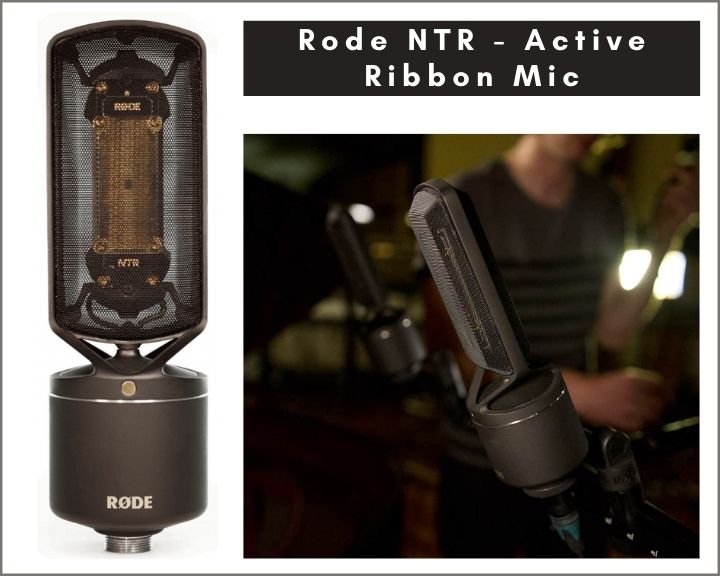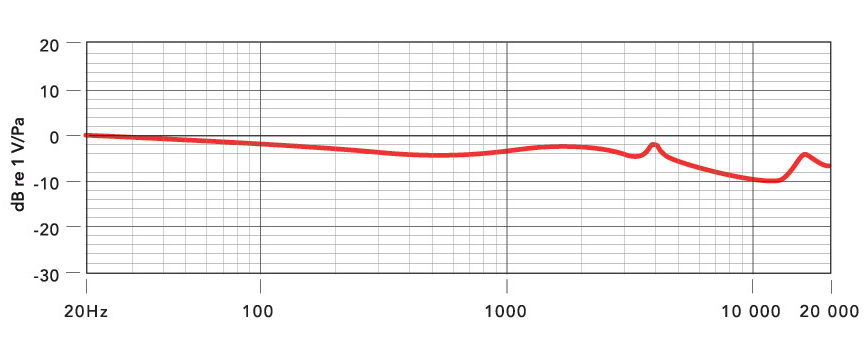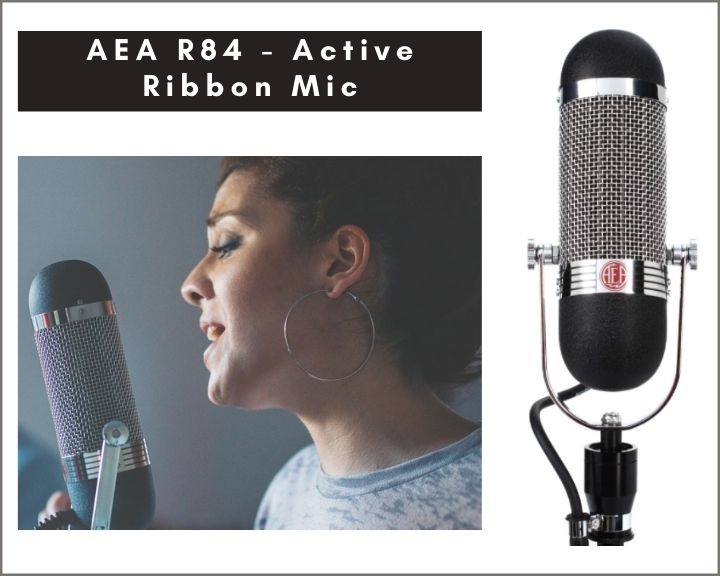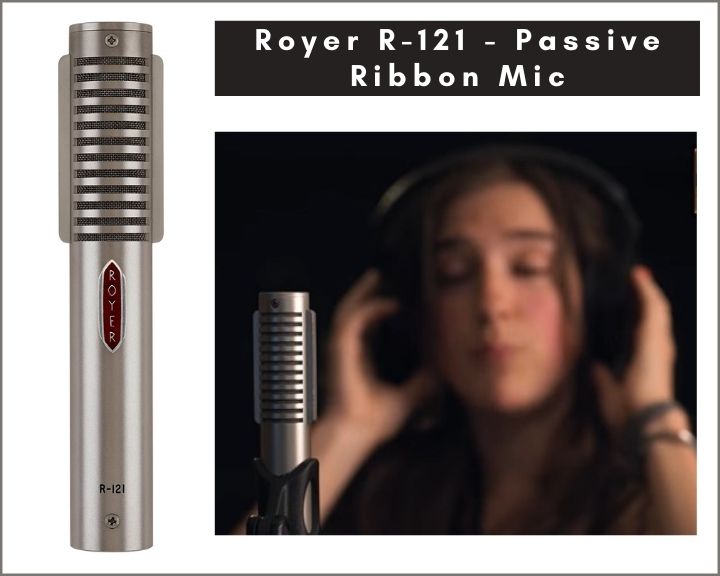Back in the 1950’s professional recordings were made using ribbon microphones. Condenser microphones were not available at that time.
Artists such as Elvis Presley, Billie Holiday, Nat King Cole, and many others recorded their albums using ribbon microphones.
Nowadays, many recording artists still use ribbon microphones because of the smooth vintage sound they deliver.
Many years have passed since their invention. Still, they are frequently used today because they can deliver a very smooth mid-range response, making vocals and instruments sound purer.
The sound naturality you get with ribbon mics cannot be achieved with any other type of microphone.
That being said, ribbon mics aren’t all rainbows and butterflies. This type of microphone can have some technical challenges.
For example, passive ribbon mics have low output, meaning that it needs a ton of gain for the signal to be strong enough in the audio chain.
As the gain increases, so does the noise, and if the ribbon is not of good quality, the self-noise will be too much, and it will sound terrible.
They have also gained a reputation of being very delicate devices because the ribbon element can break easily. The good news is that with modern manufacturing processes, now ribbons are more robust but are still more delicate than your typical SM58 dynamic mic.
There are many brands and models in the market, and some of these microphones are very expensive, running in the thousands of dollars, so how would you know which one is the best ribbon mic for vocals that is not too expensive and can deliver the best ribbon sound?
In this post, we answer that question, and some other frequently asked questions about ribbon mics.
The Best Ribbon Microphones for Vocals
If you are in the market for getting the best ribbon microphone for recording vocals or live performance, here are the ones you should consider depending on your budget:
Let’s take a closer look at each one of these microphones.
Rode NTR – It Delivers Beautifull Balanced Classic Tone

Are you looking for a clear, mellow, and impressively detailed sound for your vocals? If that’s the case, you need to get the Rode NTR ribbon microphone. Here is why.
It Delivers a Strong Signal and Low Noise
One of the characteristics of ribbon microphones is that they have a low output volume, which means that it needs a lot of gain to produce a strong enough signal to be recorded or amplified.
If you don’t have a high-end preamp, as you increase the gain, you will also be increasing noise, which produces a hiss in the captured sound.
Rode has solved this issue by making the NTR an active ribbon mic requiring phantom power to work.
This is because it has internal circuitry that amplifies the signal right at the source to increase its level providing you with a strong, clear sound with very little noise.
Your Vocals Will Sound Mellow, Warm, and With Balanced Tones
Ribbon mics are characterized for producing a sound that is quite dark because they aren’t very pronounced at the higher frequencies of the audio spectrum.
With the Rode NTR this is not the case. Thanks to its precise laser cut 1.8-micron membrane design, it can capture detailed sound with the kind of inherent tone that only ribbon mics can produce.
The NTR provides a wide frequency response with good accentuated high-end and strong low-end in a balanced way, always keeping the characteristic sound of ribbon mics. This gives you the possibility of using this microphone on any source delivering outstanding results.
High-Quality Components and Manufacturing Process
When it comes to quality, Rode doesn’t take shortcuts. Each one of their microphones, including the NTR are designed and manufactured in-house in Australia.
Most of the components like the impedance matching transformers and electronic circuitry are made in their plant, keeping quality control to a maximum.
The NTR mic has a 10-year warranty that includes one free ribbon replacement during the warranty period.
The build quality of the Rode NTR is excellent. It is robust, unlike most ribbon mics. The element is of good quality, and the whole unit itself is held in suspension by a very clever system design so that no third-party shock mount is necessary to use it.
Features:
- The ribbon element is only 1.8 microns, designed to provide the highest sensitivity across the useable frequency response range.
- Bi-Directional Polar Pattern
- Integrated internal shock mounting system so that no external mount is needed.
- Custom designed and manufactured transformer for better performance.
- Heavy-duty matte black finish
- Ribbon-securing travel screw supplied
- Designed and manufactured in Australia
- One free ribbon replacement during the warranty period.
- Ten-year extended warranty when you register your microphone on Rode’s website.
NTR Technical Specifications
- Acoustic Principle: Velocity Transducer
- Active Electronics: Step-up Transformer and signal balanced preamp stage
- Polar Pattern: bidirectional
- Address Type: Side
- Frequency Range: 20Hz – 20kHz
- Output Impedance: 200Ω
- Maximum SPL: 130dBSPL
- Sensitivity: -30.5dB re 1 Volt/Pascal (30.00mV @ 94 dB SPL) +/- 2 dB @ 1kHz
- Equivalent Noise Level (A-weighted): 15dBA
- Power Requirements: +48V phantom power
- Weight: 1047g – 2.30lbs
- Dimensions: 216mmH x 65mmW x 65mmD
- Connection Type: XLR Output
- Warranty: 1 year with free extension to 10 years after registering the product.
Polar pattern
The NTR, as most ribbon microphones, is bidirectional with a figure-eight polar pattern. This means that it picks up sound from the front and rear and not from the sides.
This type of polar pattern picks up ambient sound; for this reason, it should be used in an acoustically controlled room.
Frequency response
The NTR has a relatively flat frequency response from 20Hz to 1kHz with a peak at 4kHz dropping down to -10dB at 10kHz. There is a small peak between 14kHz and 16kHz.
What this means in sound terms is that this mic can produce a relatively uncolored smooth mid-range when compared to other microphones. It also delivers clear highs but not so much as to saturate the sound.
With this frequency response, the microphone delivers warm, clear vocals with the signature characteristic sound that only ribbon microphones can offer.
Another application for this mic is to use it as an overhead mic when recording orchestra or drums, delivering excellent results.

Sound Demonstration of the Rode NTR
Phantom Power and Additional Circuitry
Most ribbon microphones don’t need phantom power to work. In fact, some of the older models or passive ones can be damaged if connected to phantom power.
The Rode NTR requires phantom power to work. The reason is because it has internal circuitry to amplify the signal coming from the ribbon element. The circuitry is designed to provide a high output level and a wide frequency response.
Handling
It is important to mention that a ribbon mic’s foil is very delicate, especially in older models.
The good news is that in modern ribbon mics like the NTR the ribbon element is installed in an internal shock mount system that protects the element from being damaged.
It also has a travel screw that secures the sensitive ribbon element and shock mount in place when not in use.
Although Rode has designed the NTR as a robust ribbon microphone, care must be taken to ensure the longevity of the mic.
AEA R84 – Delivers a Full Rich Tone Rivaling Legendary Brands

One of the secrets for getting the best results when miking vocals is to keep the EQ to a minimum to get the most natural sound possible. But to achieve that, you need the right microphone that brings out your voice’s details without coloring the sound.
With the AEA84 ribbon mic, you don’t need to EQ much to get beautiful, rich-sounding vocals. Plus, it will bring out the details of your voice in a gentle way.
Get a Modern Mic that Delivers Classic Sound
A classic sound from a ribbon mic is characterized as being warm and smooth, but it tends to lack in the higher frequency range in some cases.
On the other hand, condenser mics are very good at picking the higher frequencies, but if not equalized correctly, it can sound harsh.
With the AEA R84 you get the best of both types of mics. It delivers a perfectly smooth mid-frequency range and balanced high frequencies.
In other words, with this mic, you will get a beautifully balanced tone, but with the signature sound that only ribbon mics can deliver.
It Delivers Outstanding Bass and Treble Response
There is nothing better than listening to a vocal performance that has a balanced tone. To achieve a balanced tone in your mix, you need a mic that picks up the sound without adding coloration, making it easy to EQ.
The AEA R84 delivers a full and rich tonality with incredible highs and lows response.
If you are trying to capture a “flawless” vocal take on your next recording project, the R84 is up to the task, and it will deliver.
Sound Demonstration of the AEA R84
Choose Between the Active or Passive Version
The R84 comes in two models, passive and active. The passive version doesn’t need phantom power to work because it doesn’t have internal circuitry, but it requires a preamp.
When dealing with passive ribbon mics, it is essential to have the best microphone preamp you can afford because your sound’s quality will depend on it.
If you don’t have a professional preamp, you can opt for the AEA R84A, which is the active version.
This version comes with a built-in JFET preamp and the same custom German toroidal transformer used in the R84 and the classic R44. For this model, you’ll need phantom power.
With the active model, you get a 12dB gain in sensitivity, making it perfect for connecting it to your audio interface, and start recording your vocals straight to the computer while delivering the classic ribbon sound.
Features and Highlights of the AEA R84 Ribbon Mic
- It’s designed with a large ribbon transducer measuring 2.35” long x 0.185” wide x 2 micron thick
- The transducer is made from pure aluminum and built using a low-tension ribbon topology for better response
- It is a versatile mic that can be used for multiple recording applications such as vocals, guitars, drums, etc.
- Thanks to its native frequency response, this mic eliminates unwanted fizz in the high-end while eliminating the low-end rumble. The result is always a tone that sounds pleasant and natural.
- The warmth, depth, and clarity that you’ll achieve with your vocals will be remarkable.
- The tone that this mic captures on female vocals is outstanding because it perfectly fits the female voice’s vocal range.
- With the AEA R84, you can get a dark and full-bodied sound that is warm, smooth, and thick all at the same time.
Specifications
General Specifications
- Polar Pattern: Bidirectional, figure-of-8 pattern
- Frequency Range: 20 Hz to 20 kHz
- Transducer: Pure aluminum corrugated ribbon
- Thickness: 1.8 μm
- Height: 11.6 in (29.5 cm)
- Width: 3.9 in (9.9 cm)
- Depth: 2.5 in (6.4 cm)
- Weight with cable: 3 lb (1.36 kg)
- Connector: XLR-3M
R84 Passive Microphone Specs
- Maximum SPL: 165 + dB SPL (1% third harmonic > 1 kHz)
- Sensitivity: 2.5 mV/Pa (-52 dBv/Pa) into unloaded circuit
- Output Impedance: 270 Ω nominal
- Recommended Load Impedance: 1.2K Ω or greater
- Phantom Power: Not required, Not recommended
R84A Active Microphone Specs
- Maximum SPL: 141 + dB SPL (1% third harmonic > 1 kHz)
- Sensitivity: 6.3 mV/Pa (-44 dBv/Pa) into unloaded circuit
- Output Impedance: 92 Ω broadband
- Recommended Load Impedance: 1.0K Ω or greater
- Phantom Power: +48 VDC phantom power, 7 mA
Included Accessories
- Softcase
- User manual
- 10 ft (3 meters) XLR cable.
Royer R-121 – A Classic Approach Delivering Warm, Realistic Tone

Have you ever wondered why some ribbon mics cost only a few hundred dollars while others are priced in the thousands of dollars?
This price difference is due to the precision manufacturing process and quality of materials to develop the membrane and transformer inside the mic.
For example, the Royer R-121 is designed and built in the U.S.A using high precision modern manufacturing processes and hand-build construction techniques. Read on to discover why you should consider this mic for your next vocal recording.
It’s All About Warmth and Natural Sound
With a ribbon element thickness of only 2.5 microns, you will be sure to capture sound in great detail while maintaining the natural sound and warmth of your voice.
It’s been said that this mic “hears” sounds like your ears do. In other words, it picks up the sound just as you hear it, yes is that natural. This sound characteristic is what you need if you want to record your voice.
Of course, in the end, it all depends on your preference. In sound engineering, there is no right or wrong; there is what works for you.
With that said, if natural sound and warm vocals is what you are looking for, you need to try the R-121 from Royer labs.
The R-121 is a Versatile Microphone in the Studio
Although this post is for the best ribbon mics for vocals, the Royer R-121 also works excellent when miking other sound sources.
You can use it to mike electric guitar and bass amps, brass instruments, kick drums, percussion, string instruments, choirs, orchestras, etc.
The beauty of using this mic is that whatever source you put in front of it will sound natural, which means that your EQ will be kept to a minimum, and bright sound sources won’t sound harsh.
You Can Sound Like a Blend Between Condensers and Ribbon Mics
Ribbon microphones have a figure of 8 polar pattern, meaning that they pick up sound from the front and back equally.
With the R-121, the backside picks up sound with a brighter tone than from the front. This can work to your advantage.
Let’s say that you want a brighter sound when recording your vocals or guitars. To achieve this, stay no more than 2 feet away from the back of the mic, and your voice will sound like if you were blending 10% condenser and 90% ribbon mic while maintaining a vintage, natural sound but with a bit more natural brightness.
There is an Active Version Similar to This Mic
As mentioned previously, ribbon mics output a small signal, so they need a high-gain, low distortion preamp to deliver a strong enough signal to work in the signal chain, and the R-121 is no exception to this rule.
The good news is that if you don’t have a professional-grade preamp, you can opt for the Royer R-122 MKII, which is the active version of the popular R-121.
With the R-122 MKII, you will get a similar tone to the R-121 but with the advantage of a signal gain of 15 dB, which will work perfectly well with an audio interface if you plan to record your voice in a home studio.
On that note, it’s worth mentioning that if you plan to mike or record crazy loud sources, go with the original R-121, which is the passive version, because it will provide you with an SPL greater than 135 dB. Perfect for miking guitar amps at high volumes or very loud vocalists.
Features
- It can be used for miking high SPL sound sources
- You can choose between the active or passive version
- Thanks to its design and construction it delivers an extremely low residual noise
- The R-121 ribbon element is not affected by heat or humidity
- Absence of high-frequency phase distortion
- It provides equal sensitivity from the front or back of the element
- You’ll get consistent frequency response regardless of distance
Technical Specifications
- Polar Pattern: Figure-8
- Transducer: 2.5-micron aluminum ribbon element
- Type of Magnets: Neodymium
- Frequency Response: 30 Hz – 15 kHz +/- 3dB
- Sensitivity: -47 dBv Re. 1v/pa
- Output Impedance: 300 Ohms @ 1K (nominal)
- Rated Load Impedance: >1500 Ohms @ 300 Ohms
- Maximum SPL: >135dB @ 20 Hz
- Output Connector: Male XLR 3 pin (Pin 2 Hot)
- Dimensions: 155.7mm L, 25mm W (6.13″ L, 1″ W) Weight: 244g (8.6 oz)
- Finish: Satin Nickel
Frequently Asked Questions About Ribbon Microphones
What is a ribbon microphone used for?
Ribbon mics are used in many different applications. They are used on vocals if a warm natural sound is the goal.
Another application for this type of mic is to use it as an overhead mic when recording orchestra and drums, delivering excellent results.
Since this type of mic is not as sensitive as condensers, they are often used when miking loud sources.
Newer ribbon mics like the Rode NTR or AEA R84A are more sensitive because they have active circuitry to boost the signal coming from the ribbon element.
Are ribbon mics good for vocals?
To answer this question, you need to know what kind of sound you are looking for.
Ribbon mics are perfect for vocals if you want a warm, natural, uncolored sound. If you prefer a bright, crisp sound, then a condenser would work better for you.
How does a ribbon microphone work?
Ribbon microphones are very simple in design. Basically, it is composed of a thin aluminum foil that is suspended between two magnets.
In other words, the foil is suspended within a strong magnetic field. When soundwaves hit the foil, it moves according to the sound energy inflicted on it.
As the thin foil moves, it causes an electrical signal to be induced in the foil. The generated signal then goes to a transformer to be boosted and sent to the preamp.
Do ribbon mics use phantom power?
Not all ribbon microphones use phantom power. Passive and older models don’t use phantom power. In fact they can be damaged by it.
Newer models like the Rode NTR and AEA R-84 use phantom power to enhance the mic’s output level and frequency range.
Are ribbon mics dynamic?
Ribbon microphones are a type of dynamic microphone because the foil is suspended between a magnetic field, and the signal is induced in the foil.
Does Royer R-121 need phantom power?
No, the Royer 121 ribbon microphone doesn’t need phantom power because there are no active internal electronics.
Final Thoughts
If you are looking for the perfect ribbon mic for your vocals that delivers a natural and smooth sound but still emphasizes the high and low-end frequencies in a balanced way, choose any of the ones mentioned in this article.
You’ll be amazed at how full-bodied, warm and beautiful your voice will sound.
The mics presented here were designed, taking no shortcuts in the process and using only good quality components and high-quality controls to deliver the best ribbon sound possible.
If you prefer a very bright, crisp sound, you better go with a condenser mic suitable for recording vocals. But, if natural, uncolored sound is your thing, nothing will make you happier than recording your voice through a ribbon mic.
I hope this article helps you to choose the right sound for your next recording.